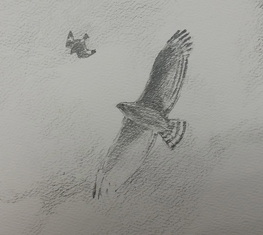| Kurt Plinke, Artist and Naturalist |
Between the Waters
life, Art and The Nature of things Between the Atlantic and the Chesapeake
 The title makes it sound as though this will be about a sunny early summer day at the beach as blisters slowly start to form on exposed shoulders. But it's not. It's more about first notes of Spring. For some people, the first notes of spring are actual notes, the jubilant bubbling calls of songbirds that warble from beaks and bills in the trees around the house. For others, it is the first brave little frog, poking a nose through the surface of vernal pools to begin repeated little peeps in hopes of finding a mate. For others, it might be the roar of air coming though an open car window when it finally becomes warm enough to drive with windows open again. For some, certain smells call up the memory of Spring. Farmers might recall the fresh smell of newly thawed dirt, almost ready to turn. Some people think of Spring when they smell cold rain on sunny pavement. Still others think of sweet-smelling hyacinth blooms, the heady fragrance drifting across the early garden. I can think of nothing that reminds me more that Spring has broken Winter's hold than a two-noted scream, floating from the sky. Living here along the Choptank River, The dominant hawk is the Red-Shouldered Hawk, a medium sized Buteo with chestnut-red shoulders and a striped tail. In the spring, the male Red-Shouldered Hawks court the females with an amazing series of diving, looping flights and loud, repeated screams. It seems that as I first begin pulling small greening winter weeds from the garden beds, I almost always hear the Red Shoulders dancing in the clouds above. They have cries that carry. Sometimes, I can pinpoint the place in the sky where their calls are coming from, but locating the birds visually is tough. Eventually, with a hand shielding the early spring sun and plenty of squinting, I can make out tiny dots looping high overhead. Despite the distance, their calls are loud and clear, as though they are soaring close overhead. Red-Shouldered Hawks have amazing courtship displays that take place in the sky over a period that spans several weeks. During these displays, the pair of hawks alternately circle each other while they repeat their two-note call. Then they take turns diving towards each other, looping as they zoom past.  When I was younger and living in Wisconsin and Ohio, I thought of the Red-Shouldered Hawk as a rare bird. Where I lived, the bigger Red-Tailed Hawks were our most often-seen hawks. Sitting on telephone poles, fence posts or on the craggy branches of dead trees, they looked so majestic looking across the landscape. Red-Shouldered Hawks were a declining and threatened species. (as were many species of Buteos) This was due, in part, to pesticides and poisons that were used routinely by farmers and homeowners. With the banning of specific pesticides, most notably DDT, the numbers of these birds have been making a steady comeback. Frogs, small snakes, mice, voles and insects make up much of the Red-Shoulder's diet. More of a woodland species that the Red-Tailed, these raptors wait patiently on a low-hanging branch, their heads tilted to catch any movement below on the forest floor or along the river's edge. Then quietly, they drop on their prey before carrying it back to the tree. Their early-spring calls and sky dances lead to nesting. Red-Shouldered Hawks typically nest for life, and while some migrate, they typically return to the same nesting area every year. Their compact but bulky nests, made of branches, usually hold three or four eggs. The female spends more time on the nest than the males, although male Red-Shoulders are good providers, carrying food to the nesting female and young. With the wooded river edge and large closely-set woodlots along the Choptank corridor, This bird can almost always be seen circling high overhead or perched on a heavy tree branch. But most of all, they call to Spring, beckoning it's return with their two-toned love song to the season.
0 Comments
Leave a Reply. |
What's News?Kurt Plinke: About Life, Art and the Nature of Things on the Eastern ShoreI write about things I've noticed, places I've been, plans I've made and paintings I've finished or am thinking about. Archives
February 2020
See recent naturalist observations I have posted on iNaturalist:
|
|
Sewell Mills Studio & Gallery
14210 Draper's Mill Road Greensboro, MD 21639 (410) 200-1743 [email protected] |
Rights to all images on this website, created by Kurt Plinke, remain the property of Kurt Plinke. Copying or use of these images is permissible only following written permission from Kurt Plinke. To use images for any purpose, contact [email protected] for permission.


